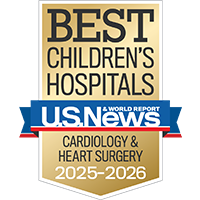Learning never stops
Our classroom and bedside classes help kids get credit and keep learning during treatment.
See our school program

Aortic stenosis is a birth defect in which the valve between the heart and the blood vessel called the aorta is deformed and too narrow to allow healthy blood flow.
The valves in the heart are like one-way doors that allow blood to flow in the appropriate direction. A healthy aortic valve is made up of three flaps, called leaflets, which open and close together. When oxygenated blood leaves the lungs, it goes into the left side of the heart and exits into the aorta, which carries blood from the heart to arteries throughout the body.
When the aortic valve is deformed, blood may back up into the heart and lungs. Aortic stenosis can be a congenital disorder (meaning it's present at birth) or can be caused by other conditions. It can affect babies, children and adults, although often symptoms don't occur until middle age or later. At one time, the condition was associated with childhood rheumatic fever, which has become less common.
There are different types of aortic stenosis that may occur independently or in combination with one another. Aortic stenosis also may occur with other heart defects. The different types include:
Critical aortic stenosis — An extremely narrow aortic valve, which causes death if not treated quickly. Severe obstruction of blood flow causes left heart failure and lung congestion. These babies may experience shortness of breath and fainting as well as low blood pressure. They may be misdiagnosed as having shock due to sepsis.
Subaortic obstruction stenosis — A narrowing just below the valve.
Supra-valvar obstruction stenosis — A narrowing just above the valve.
Valvar stenosis — The valve opening has only one or two leaflets instead of the normal three.
Aortic stenosis is rare in infancy, occurring in only about a third of one percent of births. Aortic stenosis can be mild, moderate or critical. Symptoms of the disease often don't appear until middle age or later. Although some people with aortic stenosis don't experience symptoms, the most common symptoms include:
Because there may be no obvious symptoms of aortic stenosis, the first sign of the condition is often a heart murmur, an extra sound the doctor hears during a chest examination. To make a definite diagnosis of aortic stenosis, the following tests may be performed:
Babies, children and young adults who have aortic stenosis can be treated surgically or with a catheter procedure that splits the deformed valve leaflets to enlarge the opening without replacing the valve. These procedures are successful only if the aortic valve is still thin enough to be manipulated.
Stenosis may return and eventually cause the valves to stiffen. Another surgery or catheter procedure may be required later in life to further repair or replace the valve.
The catheter procedure is called balloon valvoplasty. During this procedure, a catheter — a thin, flexible, plastic tube — is inserted into the heart via blood vessels in the leg. Catheters can be used to carry very small instruments or repair devices, such as a balloon, to the heart. A balloon at the tip of the catheter is inserted into the narrow opening in the valve and then inflated to stretch the valve opening and separate the valve leaflets.
This balloon procedure, which opens the blocked valve in most patients, is performed in our Cardiac Catheterization Laboratory. Occasionally, a patient's valve will leak after the balloon procedure and a surgical repair is necessary.
For adults with severe aortic stenosis, treatment is more likely to include surgical replacement with either a manufactured valve or valve from another person. Another surgical repair involves removing obstructive tissue, which may be done with valve replacement.
Patients with aortic stenosis are given antibiotics to avoid heart infections during surgery or dental work. Medications may be used to control symptoms of aortic stenosis, such as high blood pressure or heart rhythm problems.
UCSF Benioff Children's Hospitals medical specialists have reviewed this information. It is for educational purposes only and is not intended to replace the advice of your child's doctor or other health care provider. We encourage you to discuss any questions or concerns you may have with your child's provider.

Best in Northern California for cardiology & heart surgery

Ranked among the nation's best in 11 specialties
Learning never stops
